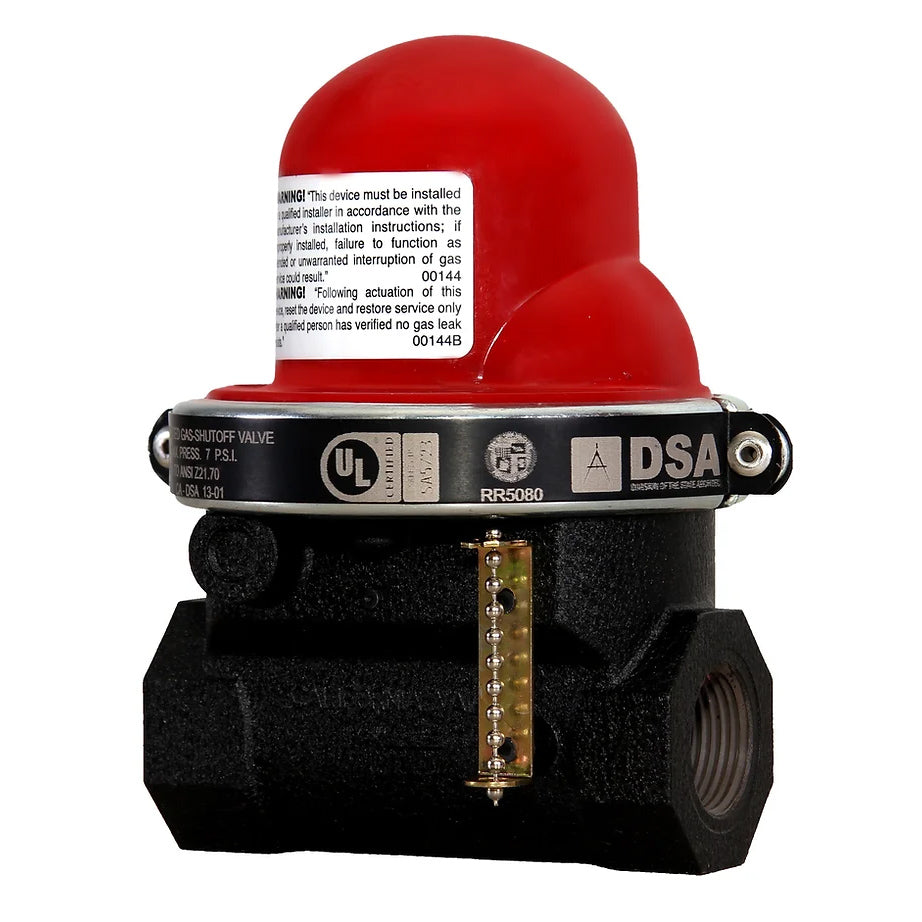Gas Valve Regulations - Marin County
ORDINANCE NO. 3322
ORDINANCE OF THE MARIN COUNTY BOARD OF SUPERVISORS
ADDING SECTION 19.04.090 and 19.04.091 OF THE MARIN COUNTY CODE RELATING TO BUILDING REGULATIONS AND SEISMIC SAFETY, ANCHORING OF LIQUID PETROLEUM GAS TANKS AND GAS SHUT-OFF DEVICES.
THE BOARD OF SUPERVISORS OF THE COUNTY OF MARIN DOES HEREBY ORDAIN AS FOLLOWS:
SECTION l. SUMMARY. This ordinance ADDS SECTION 19.04.090 and 19.04.091 to the Marin County Code to require the installation of Excess Flow Gas Shutoff Devices (non-motion sensitive) or Gas Shutoff Devices that are activated by motion. These devices are to be installed on gas services downstream of the meter in new construction and remodeling. Liquid petroleum gas tanks are being required to be anchored. This ordinance will be effective sixty (60) days from the date it is passed. [Gov. Code § 25129].
SECTION ll GAS SHUT-0FF DEVICES. Section 19.04.090 is added to the Marin County Code to read:
19.04.090 GAS SHUTOFF DEVICES.
A) DEFINITIONS. For the purpose of this section certain terms shall be defined as follows:
1) "Downstream of Gas Utility Meter" shall refer to all customer-owned gas piping or in liquid petroleum gas installations shall refer to the gas piping on the structure side of the gas regulator.
2) "Residential Building" shall mean any single family dwelling, duplex, apartment building, condominium building, townhouse building, lodging house, congregate residence, hotel, or motel.
3) "Excess Flow Gas Shutoff Device" shall mean those valves or devices that are not actuated by motion, but are activated by significant gas leaks or overpressure surges, which can occur when pipes rupture inside the structure. The design of the device shall provide a proven method to automatically provide for expedient and safe gas shutoff in an emergency. The design of the device shall provide a capability for ease of consumer or owner resetting in a safe manner. The device shall be certified by the State Architect or the operational and functional design of the device shall meet or exceed the device certified by the Office of the State Architect. The determination of whether the operational and functional design of the device is at least equal to the device certified by the State Architect may be made by one of the following: the Independent Laboratory of the International Approval Services (IAS), Underwriter's Laboratory (UL), International Association of Plumbing and Mechanical Officials (IAPMO), or other recognized listing and testing agent.
4) "Seismic Gas Shutoff Device" shall mean a system consisting of a seismic sensing means and actuating means designed to actuate automatically a companion gas shutoff means installed in a gas piping system in order to shut off the gas downstream of the location of the gas shutoff means in the event of a severe seismic disturbance. The system may consist of separable components or may incorporate all functions in a single body. The device shall be certified by the State Architect, and the operational and functional design of the device shall meet or exceed the device certified by the Office of the State Architect. The determination of whether the operational and functional design of the device is at least equal to the device certified by the State Architect may be mode by one of the following: the independent Laboratory of the International Approval Services (IAS), Underwriters Laboratory (UL), International Association of Plumbing and Mechanical Officials (IAPMO), Office of the State Architect or any other recognized listing and testing agency.
5) "Upstream of Gas Utility Meter" shall refer to all gas piping installed by the utility up to and including the meter and the utility's bypass tee at the connection to the customer owned piping.
6) "Gas Shutoff Device" as used in this Ordinance, shall refer to either a Seismic Gas Shutoff Device or Excess Flow Gas-Shut-Off Device.
ORDINANCE NO. 3322
B) DEVICES: WHEN REQUIRED. An approved Seismic: Gas Shut-Off Device (motion sensitive) or approved Excess Flow Gas Shutoff Devices (non-motion sensitive) shall be installed:
1) In any new building construction (commercial, industrial or residential) containing gas piping for which a building permit is first issued on or after the effective date of the ordinance; or
2) In any existing residential, commercial or industrial building, when any addition or alteration Is made to the interior of a building that contains gas piping, and a building permit is required for said work; or
When any plumbing permit is issued for gas piping.
C) EXCEPTIONS.
1) Gas-Shut-Off Devices installed on a building prior to effective date of this ordinance, are exempt from the requirements of this section provided they remain installed on the building or structure and are maintained for the life of the building or structure.
2) Gas Shutoff Devices installed on a gas distribution system owned or operated by a public utility shall not be subject to the requirements of this chapter (Health & Safety. Code § 19201 (b)).
Installation of gas Shut-off devices is not required for building permits issued for minor and non-structural repairs such as re-roofing, window replacement, siding replacement, decks and any other minor permit as determined by the Chief Building Official.
D) DEVICES: LOCATION REQUIRED.
1) Seismic Gas Shutoff Devices shall be installed downstream of the gas utility meter or liquid petroleum tank on each fuel gas line where the gas line services a building and/or:
2) Excess Flow Gas-Shut-Off Devices shall be installed downstream of the gas utility meter or liquid petroleum tank on each fuel gas line where the gas line serves a building and at each gas appliance within a building.
E) GENERAL REQUIREMENTS. Gas-Shut-Off Devices installed either in compliance with this ordinance or voluntarily, with a permit issued on or after the effective date of this ordinance, shall comply with the following requirements:
1) Be installed in accordance with the manufacturers instructions.
2) In the case of Seismic Gas-Shut-Off Devices (motion sensitive) only, such devices must be mounted rigidly to the exterior of the building or structure containing the fuel gas piping. This requirement need not apply if the Building and Safety Division determines that the seismic gas shutoff device (motion sensitive) has been tested and listed for an alternate method of installation.
3) Seismic Gas-Shut-Off Devices shall be certified by the State Architect and be listed by an approved listing and testing agency such as IAS, IAMPO, UL or the office or the State Architect.
4) Have a thirty (30) year warranty which warrants that the valve or device is free from defect and will continue to properly operate for thirty (30) years from the date of installation.
Where Gas Shutoff Devices, are installed voluntarily or as required by this section, they shall be maintained for the life of the building or structure or be replaced with a valve or device complying with the requirements of this section.
F) LIST OF APPROVED VALVES AND DEVICES. The Building and Safety Division of the Community Development Agency shall maintain a list of all Seismic Gas-Shut-Off Devices (motion sensitive) and Excess Flow Gas-Shut-off Devices (non-motion sensitive) which meet or exceed the requirements of devices certified by the Office of the State Architect for installation in the State of California and which comply with the standards and criteria set forth in Health and Safety Code section 19180 et seq, Including quality and design regulation for earthquake actuated automatic gas shutoff systems (see 24 Cal. Code Regs. Ch. 12-16-1).
ORDINANCE NO. 3322
<< - Page 3 -
SECTION lll. LIQUID PETROLEUM GAS TANKS. Section 1904.091 is added to the Marin County Code to read as Follows:
19.04.091 ANCHORING OF LIQUID PETROLEUM GAS TANKS.
A) WHEN REQUIRED. Liquid petroleum gas (LPG) tanks shall be anchored by a system approved by the administrative authority or designed by a licensed engineer, to prevent overturning in seismic events, installation of such anchoring system shall be required as follows:
1) For any new building construction (commercial, industrial or residential) containing LPG piping for which a building permit is required; or
2) For any alteration or addition to any existing residential commercial or industrial building which contains LPG piping, and for which a building permit is required; or
3) Upon replacement or addition of a new liquid petroleum gas tank, or for initial installation or for repair of the gas piping system (LPG).
B) EXCEPTION. Liquid petroleum gas (LPG) tanks are not required to be anchored upon the Issuance of building permits for minor and non-structural repairs such as re-roofing, window replacement, siding replacement, decks and any other minor permit at determined by the Chief Building Official,.
SECTION lV.- FINDINGS. Pursuant to Sections 17958.5 and 17985.7(a) of the State of California Health and Safety Code, the Board of Supervisors finds that the adoption of certain construction standards which may be stricter that those set forth pursuant to the State's earthquake protection law (Health & Safety Code Section 19100 et scq.) are needed and are reasonably necessary because of local climatic, geographic and topographic conditions.
SECTION V: EFFECTIVE DATE. This ordinance is enacted pursuant to and in compliance with Health and Safety Code Section 18941.5 and as expressly permitted in Government Code Section 50022.2 and shall be, and is hereby declared to be, in full force and effect as of sixty (60) days from and after the date of its passage and shall be published in the Marin Independent Journal, once before the expiration of fifteen (15) days after its passage.
SECTION VI: VOTE
PASSED AND ADOPTED at a regular meeting of the Board of Supervisors of the County of Marin held on this 1st day of May, 2001, by the following vote:
AYES: SUPERVISORS Cynthia L. Murray, John B, Kress, Annette Rose, Harold C, Brown, Jr.
NOES: NONE
ABSENT: SUPERVISOR Steve Kinsey


